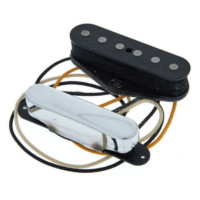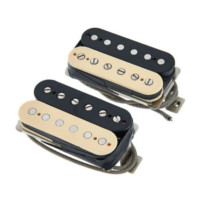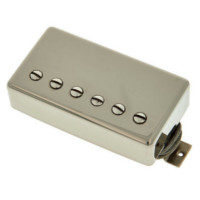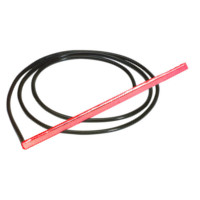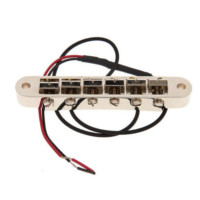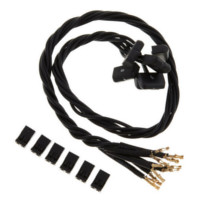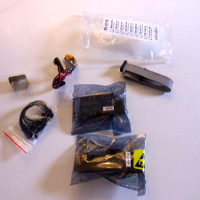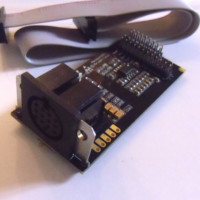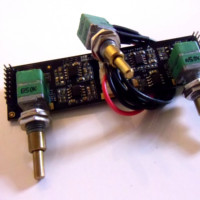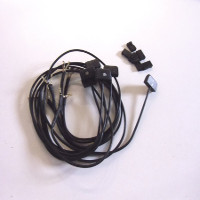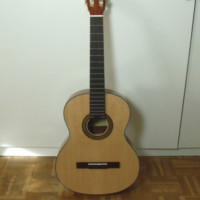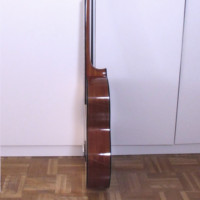The Electro Classical Guitar
Here I explain how I added a MIDI piezo pickup to a conventional nylon string guitar, to allow connecting it to conventional electric guitar pedals and amplifiers and also to MIDI guitar synths.
Electric or electronic sounds with nylon.. why not!?
The vibration of metal strings can be acquired with magnetic pickups, with piezoelectric pickups and also with conventional audio microphones. Magnetic pickups are the most used type of pickups in metal strings guitars, and there is a wide range of types and prices of this kind devices. On the other hand, nylon strings only can be recorded with piezo pickups or conventional audio microphones. Piezo pickups systems are also less common, and more expensive than standard magnetic pick-ups. The sound response of both types of pick-ups is also a bit different.
Nylon string guitars ( like classical or spanish guitars ) tend to have much less connection and interfacing possibilities than metal string guitars ( like electrical or electro-acoustic guitars ). Most nylon string guitars are acoustic, while metal strings guitars can be acoustic or electric. Metal string guitars sound more bright ( more metallic ) than nylon string guitars. Playing technique of both type of guitars is also different.
Magnetic pickups can also be combined in different places near the strings to get different sounds, something that it is not possible with piezo pickups. They can also be used in guitars with special bridges, like Floyd Rose or other vibrato bridges. But despite magnetic pickups allow more combinations and sound options, there is not a strong technical reason that impedes using a nylon string guitar to record electric or electronic guitar sounds.
In most cases, those who want to distort or process the sound of a guitar, choose an electric, or in some cases an electro-acoustic, guitar with magnetic pickups. Nylon string guitars are rarely chosen for "electric or electronic" music, but... why ? One of the reasons may be that there are not too much nylon string guitars prepared with convenient pickup systems in the market. Another reason may be that we are not used to see that type of guitars used by musicians who play that kind of music, so It seems strange to us to see somebody using that guitars for "electric" or "electronic" music styles. But nylon string guitars can also be electric.
Maybe it wouldn't be a good idea to use an expensive classical or spanish guitar with piezo pickups to play more "electrified" music styles because these kind of guitars are specially designed and built to work as acoustic guitars. Compared to conventional electric guitars, they have a big hollow body built with quality woods to resonate and create a nice sounds, but this is useless if we only want to capture the vibration of the strings to send them to a sound processor to modify or distort it. Few guitar manufacturers like Godin, have on their catalogue models of electrified nylon string guitars, some also with MIDI connectivity, but they are rare and expensive if we compare them to conventional electric guitars.
Preparing my own electrified nylon strings guitar
I am an amateur guitar player, and I use my spanish guitar to play simple pop songs and some riffs. I've always loved the sound of electric guitars, and some years ago I bought an electrical guitar, but didn't get used to it and gave up on playing it. The playing technique and the feeling of electrical guitars is different from the the technique and the feeling of nylon string guitars.
But I still wanted to create that kind of electric sound on my nylon string guitar. Also wanted to enjoy similar recording and processing possibilities. For that reasons I thought on buying a commercial "electrified" nylon string guitar with MIDI options but they are very expensive and difficult to find. As I couldn't afford one of these guitars I decided to create one by myself. The initial idea was to buy a commercial standard nylon string guitar to add to it the same piezo pickups and components used by those expensive guitars.
The first step was finding a piezo-pickup that matched my requirements. I was looking for a piezo pickup system which allowed me to use a nylon string guitar with the typical guitar mono audio jack cable but also with the 13-pin MIDI cable. There are a lot of models of piezo pickups designed to be placed under the guitar saddle which capture the sound of all the strings and provide a jack mono audio output. But in these pickups there is only one sensor for all the strings, they don't allow recording the sound of each string separately, and this is a requirement to use the guitar with a 13-pin MIDI system.
On 13-pin guitar cables the sound of each string is sent separately to the sound processor where it is processed and mixed to create the final patch sound. This 13-pin system is the one used by most part of guitar MIDI processors and offers much more processing possibilities than only sending the sound of all the strings together "mixed" through the same wire. So I had to find a pickup system prepared to capture the vibrations of each string separately ( this implies using 6 piezo sensors, one per string ) to send them through the 13-pin cable but also through the mono standard cable.
There are not too much manufacturers of these kind of picks ups. I only found two: RMC and Graphtec. RMC pickups are very difficult to find, there is not to much information about them, and It seems that the distributor doesn't sell to particulars, only to retail guitar manufacturers. In the other hand Graphtec pickups are easier to find, can be bought in different stores, are available in different kits, and have very good documentation. I checked Graphtec catalogue and I found what I was looking for: the GraphTech Ghost Acoustic MIDI System for nylon strings . This kit includes all the components I needed to add a standard mono jack and a 13-Pin MIDI output connectors to a nylon string guitar:
-6 Individual ghost Acoustic MIDI Nylon pickups
-ghost tone control preamp board
-ghost Acoustic / Hexpander preamp board
-Hexpander interface wiring harness
-Battery holder ( for the acoustic system )
-13-Pin and jack output connectors
-6 Individual ghost Acoustic MIDI Nylon pickups
-ghost tone control preamp board
-ghost Acoustic / Hexpander preamp board
-Hexpander interface wiring harness
-Battery holder ( for the acoustic system )
-13-Pin and jack output connectors
I searched on different stores and in all them the price of the kit was over 300$, but at the end I found an offer of a kit ( in sweetwater ) which did not include the metal mounting plate but was 90$ cheaper ( around 190 Euros ). I bought it.
Next step was finding the nylon string guitar to install the piezo pickup system on it. It made no sense to use a high quality guitar, because I was going to make holes and other modifications to install the components on it. The woods used in a guitar are one of the most important elements that control the final sound of the instrument, and good woods are expensive. But as I was not interested in the acoustic sound of the instrument, and as I was going to mute it placing foam inside the guitar body box, they were not important for me. It does not mean that any guitar was useful to place the pickup: there are cheap guitars, most of them made in china, which are not well built and are a pain to play. The idea was to find a simple but well built standard nylon string guitar to install in the piezo pickup.
I visited some guitar shops in Madrid searching for a guitar model which matched my requirements, and at the end I decided for a Guitarra Caballero 8 ( by Manuel Rodriguez e Hijos ). I tried it in the shop and I liked it. It was what I was looking for: simple, well built, well finished, easy to play and at a very reasonable cost ( 150 Euros )
Instead of a normal spanish guitar, maybe It would have been better to use a nylon string guitar with a thinner body box to make the instrument more comfortable to play. But these thinner guitars are more difficult to find and more expensive because they usually are already "electrified".







